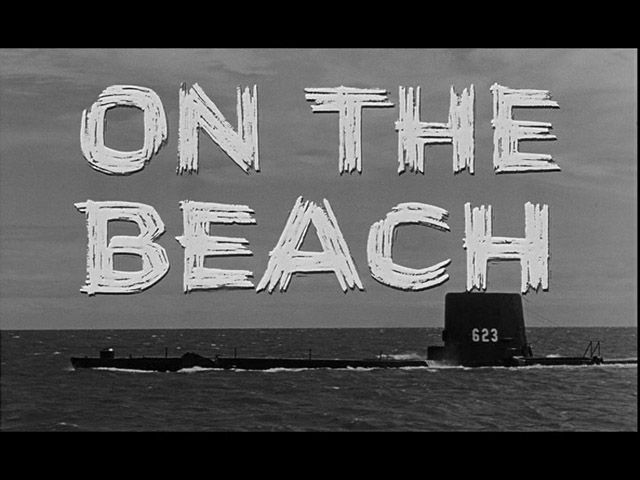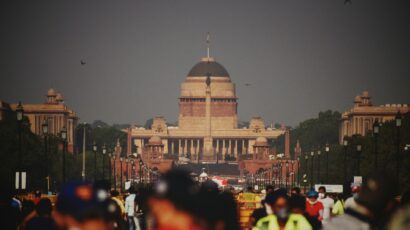The continuing relevance of “On the Beach”
By Beverly Gray | August 3, 2015

“It frightened the hell out of me. I’m still frightened.”
These words mark the reaction of a young Australian named Helen Caldicott to a story of the aftermath of mistaken nuclear war, in which those who never even took sides were faced with the slow advance of deadly nuclear radiation on their shores. On the Beach, first a best-selling novel and then a major Hollywood film, confronts the viewer with a number of questions: How would you behave if—in the aftermath of a nuclear apocalypse—you knew you only have a few weeks or months left to live? Would you carouse riotously, knowing the end is near? Deny that the entire thing is happening? Hope against all logic for a miraculous reprieve? Try to maintain a core of decency in the face of imminent death? Wish that you had done something long ago to prevent nuclear war in the first place?
The story’s effect on Caldicott, then a 19-year-old Melbourne medical student who’d just learned about genetics and radiation, was profound. She went on to become both a pediatrician and a feisty anti-nuclear activist, an inspiration to others in the non-proliferation community and in the nuclear humanitarian initiative. She is renowned for warning, “It could happen tonight by accident,” and with the onset of nuclear winter, “We’ll all freeze to death in the dark.”
But what about the book itself and the 1959 movie made from it? Recently, after watching a 2013 documentary called Fallout (produced by Rough Trade Pictures in association with Screen Australia and Film Victoria) that ponders these questions, I sat down with Karen Sharpe Kramer, widow of the producer-director of On the Beach. Stanley Kramer was well-known for releasing such “message” films as Judgment at Nuremberg, Inherit the Wind, and Ship of Fools. Of On the Beach he once wrote, “Its subject was as serious and compelling as any ever attempted in a motion picture—the very destruction of mankind and the entire planet.” Kramer died in 2001, but as the Iran nuclear agreement, renewed US-Russian nuclear tensions, and the 70th anniversary of the Hiroshima and Nagasaki bombings make headlines, his Eisenhower-era movie retains an unfortunate relevance.
A different time—or maybe not so different. Sixty years ago, as the Cold War intensified, the end of the world seemed much too close for comfort. The threat of nuclear destruction, implicit in the newspaper headlines of the day, naturally leached into popular culture. The first filmmakers to incorporate the potential for global apocalypse into their work were the makers of low-budget horror flicks, like 1953’s The Beast from 20,000 Fathoms and 1954’s Godzilla. Such movies both shocked and titillated young audiences by positing that nuclear tests had unleashed huge, fearsome monsters that—metaphorically standing in for the Bomb itself—could not be contained.
While teenagers were at the movies, their parents were building backyard fallout shelters in hopes of surviving the coming nuclear holocaust. Then suddenly a book appeared that spoke on an adult level to the futility of bomb shelters and the era’s duck-and-cover drills. This was On the Beach, published in 1957 by a British-born aeronautical engineer. Nevil Shute, who had once worked on the first British airship, spent much of World War II helping the Royal Navy develop experimental weapons in preparation for the D-Day invasion. By the time Shute transplanted his family to Melbourne, Australia, he had already begun publishing a long string of adventure novels. But in the post-war years, he felt a special need to convince the public of the dangers posed by nuclear proliferation. Through the character of Julian, he acknowledged the complicity of the scientists who had helped create weapons of mass destruction. In many ways, Shute personally identified with Julian, who must admit that “the devices outgrew us, we couldn’t control them. I know. … I helped build them, God help me.”
This dialogue comes from the 1959 film version. Shute’s On the Beach had quickly become a worldwide sensation. In its first six weeks, the American edition of the book sold 100,000 copies, dislodging the steamy Peyton Place from its top spot on the nation’s bestseller lists. Of course a cinematic adaptation was inevitable, and the socially aware Stanley Kramer (whose just-released prior film, The Defiant Ones, had tackled racial prejudice in the Deep South) quickly bought the movie rights. He cast major Hollywood stars in the central roles and moved his company to Melbourne to shoot one of the first feature-length Hollywood movies ever to be made on Australian soil.
The plotline of On the Beach is simple but powerful. Somewhere in the Northern Hemisphere, some kind of horrible misunderstanding has launched a nuclear war, quickly wiping out most of the world. As one character in the book puts it: “No, it wasn’t an accident, I didn’t say that. It was carefully planned, down to the tiniest mechanical and emotional detail. But it was a mistake.” Though Australia and a few other countries at the far reaches of the Southern Hemisphere have remained untouched, its citizens must now await the coming of the radiation that is sure to kill them all. (In the words of the Daily Telegraph, “a city waits, defeated, for the end of the world, whiling away the remaining hours with suicidal sport.”)
In this highly charged environment, a married American submarine commander (Gregory Peck), posted to Melbourne in the line of duty, is attracted to a beautiful and hedonistic local woman (Ava Gardner). Meanwhile, a young Aussie couple (Anthony Perkins and Donna Anderson) struggle with the realization that when the sickness comes, they may need to kill their infant daughter as well as themselves. As for Julian the scientist (played by an unlikely but mesmerizing Fred Astaire), he tries to cope by way of cynicism and a reckless disregard for life and limb while competing on a local speedway.
Transferring the book to film must have been a challenge in itself; the book begins with the lines: “This is how the world ends; not with a bang, but a whimper.” Consequently, there is not much room for big visuals or special effects; there are no big fiery explosions, and no scenes in which a John-Wayne type can charge up a hill in the face of the enemy. In fact, we see nothing of the millions who would have died of burns, internal injuries, or other unspeakable afflictions from a nuclear war. As modern-day fans of Nevil Shute’s literary work can attest: “For a novel about the complete extermination of life on Earth, On The Beach is surprisingly quiet. The distance from the original war, with its obviously horrific consequences, and the fundamental decency of the characters, shields the reader from the mess. Indeed, when Peter Holmes shouts at his wife the effects of radiation sickness on their baby, it is possibly the most stomach-wrenching part of the book.”
In the film, the most haunting section is similarly quiet, involving the submarine’s voyage to the west coast of the United States in hopes of finding survivors. Stanley Kramer’s direction is at its best in this segment, filmed completely without sound or musical scoring. One by one, each of the crew members takes a turn looking through the periscope at a still and silent San Francisco. On the wharves, on the bridges, not a single sign of life.
The intensity of this moment is matched by the film’s final shot. Kramer’s On the Beach opens with a montage of Melbourne’s lively downtown business district: pedestrians and vehicles come and go, while a sidewalk evangelist gathers a crowd under a banner that proclaims “THERE IS STILL TIME … BROTHER.” At the film’s end, after the deadly radiation has made its presence felt, the banner continues to flap in the breeze. But there’s no one to read its message of hope.
The audience take-away. On the Beach, of course, stems from an era when nuclear weapons were primarily in the hands of two world superpowers. Today there seems to be powerful nuclear capability in virtually every global neighborhood. Which makes the message of this novel and this film all the more timely.
“THERE IS STILL TIME … BROTHER” can be taken as the underlying message of On the Beach. Both novel and film are consciously urging the public to avert calamity. One who responded strongly was Caldicott, who vividly remembers the impact the book made on her: “It just penetrated every bone of my body. … That an episode in the Northern Hemisphere could destroy the Southern Hemisphere and everything on it was almost unimaginable.”
And a young Hollywood actress named Karen Sharpe, who’d been featured in The High and the Mighty, was one of many who fell under the spell of the Stanley Kramer film. She saw it at Grauman’s Chinese Theater, deliberately choosing an afternoon performance to beat the crowds. It didn’t work: the big auditorium was jam-packed. She has never forgotten her first reaction to On the Beach: “It was devastating.”
Seven years later, Karen Sharpe came to know Stanley Kramer; they were married from 1966 until his death in 2001. The two worked together on several of Kramer’s later films, notably Guess Who’s Coming to Dinner. Still, of the entire Kramer output, On the Beach remains perhaps Karen’s favorite. She staunchly defends Kramer against the complaints made by Nevil Shute at the time of the film’s first screening. Shute had loudly protested that the film was a “bastardization” of his work because of its American cast and what he saw as the soft-peddling of the horrors of radiation sickness, which include nausea, vomiting, fever, skin and hair loss, massive ulcers, blisters, burns, emaciation, destruction of the soft tissues, bone marrow depletion, and ultimately inflammation of the membrane around the heart, leading to a slow, agonizing death.
Shute, who never depicted adultery in any of his novels, seemed particularly outraged that the characters played by Gardner and Peck discreetly consummate their relationship within the film, even though he’s technically a married man. Karen Sharpe Kramer firmly believes in Stanley’s choice: “You never know what people will do in time of disaster. People will cling to life and hope and love as long as they can.” Besides, there’s a practical consideration: “I don’t think you can have a platonic relationship for two solid hours when you have the end of the world. You have to have something to give the audience to really care about those people.”
Karen also applauds her late husband for his marketing savvy. Hoping to make the greatest possible stir on the global scene, Stanley Kramer scheduled premieres of On the Beach in 18 world capitals—including Tokyo, London, Paris, Berlin, Stockholm, Caracas, and New York City—on the very same day, December 17, 1959. Heads of state attended many of the screenings, along with the movie’s stars. Ava Gardner, for instance, was dispatched to Madrid, while Gregory and Veronique Peck traveled to Moscow, where they watched the film in the company of 1,200 Soviet apparatchiks.
This innovative world premiere helped nudge the United Nations toward considering disarmament talks, while also drumming up business at the box office. It didn’t hurt to have a publicity campaign that featured the tagline, “The Biggest Story of Our Time.” And most print ads of the day were also emblazoned with this imperative: “If you never see another motion picture in your life, you MUST see On the Beach.”
Critical response to the film was mixed, however, and audiences—at least in the United States—did not turn out in the numbers Kramer had hoped for, despite the packed theatre at Grauman’s. The film recorded a loss at the time of $700,000. Of course the grim subject matter surely kept many moviegoers away. Variety said that “the final impact is as heavy as a leaden shroud. The spectator is left with the sick feeling that he’s had a preview of Armageddon, in which all contestants lost.”
In Australia, however, On the Beach seemed to do better. Partly this relates to the fact that the movie was made on location in Melbourne, with local sights and sounds featured on screen—always enticing to an audience. (Philip Davey has written about the excitement generated by the film’s production in his When Hollywood Came to Melbourne.) Also, On the Beach dealt explicitly with the dilemma of what the Southern Hemisphere would face if the Northern Hemisphere resorted to nuclear war. But there may have been a deeper reason, connected with the differing nature of the two countries: Australia is a land of stoics, with a fatalistic view, based upon the country’s founding as a prison colony, while (most) Americans came here willingly. The two nations have also had different histories and different experiences with their respective vast, untamed continents—as is reflected by each country’s choice of frontier heroes. While American heroes tend to be victorious strivers who subdue the land, nearly every Australian national hero dies, from the fatal Burke and Wills expedition in the outback to Simpson at Gallipoli. We Americans like winners; the Aussies admire the beautiful loser, who retains his humanity, defiance, and sense of life, even in defeat. Consequently, the themes of On the Beach have had a special resonance down-under.
Film critics in the Northern Hemisphere seemed to have missed that point, with a notable exception being Bosley Crowther of the New York Times, who wrote in his 1959 review that “[t]he basic theme of this drama and its major concern is life, the wondrous thing that man’s own vast knowledge and ultimate folly seem about to destroy. And everything done by the characters, every thought they utter and move they make, indicates their fervor, tenacity and courage in the face of doom. … Mr. Kramer and his assistants have most forcibly emphasized this point: Life is a beautiful treasure and man should do all he can to save it from annihilation, while there is still time.”
Together, we make the world safer.
The Bulletin elevates expert voices above the noise. But as an independent nonprofit organization, our operations depend on the support of readers like you. Help us continue to deliver quality journalism that holds leaders accountable. Your support of our work at any level is important. In return, we promise our coverage will be understandable, influential, vigilant, solution-oriented, and fair-minded. Together we can make a difference.
Keywords: popular culture
Topics: Analysis, Book Review, Nuclear Weapons, Special Topics
















This is beautifully written and an accurate analysis of this incredible book. I’ve just finished reading it for the second time and watched the film again last night. Both stay with you for a very long time because you can’t stop thinking about the inevitability of the end. Not pleasant, but the feeling makes you appreciate what you’ve got. As for Peck and Gardner getting it on in the film, I think it’s closer to reality than Shute wanted to go in the book. I admire his restraint, but let’s face it – the human condition in those circumstances will… Read more »